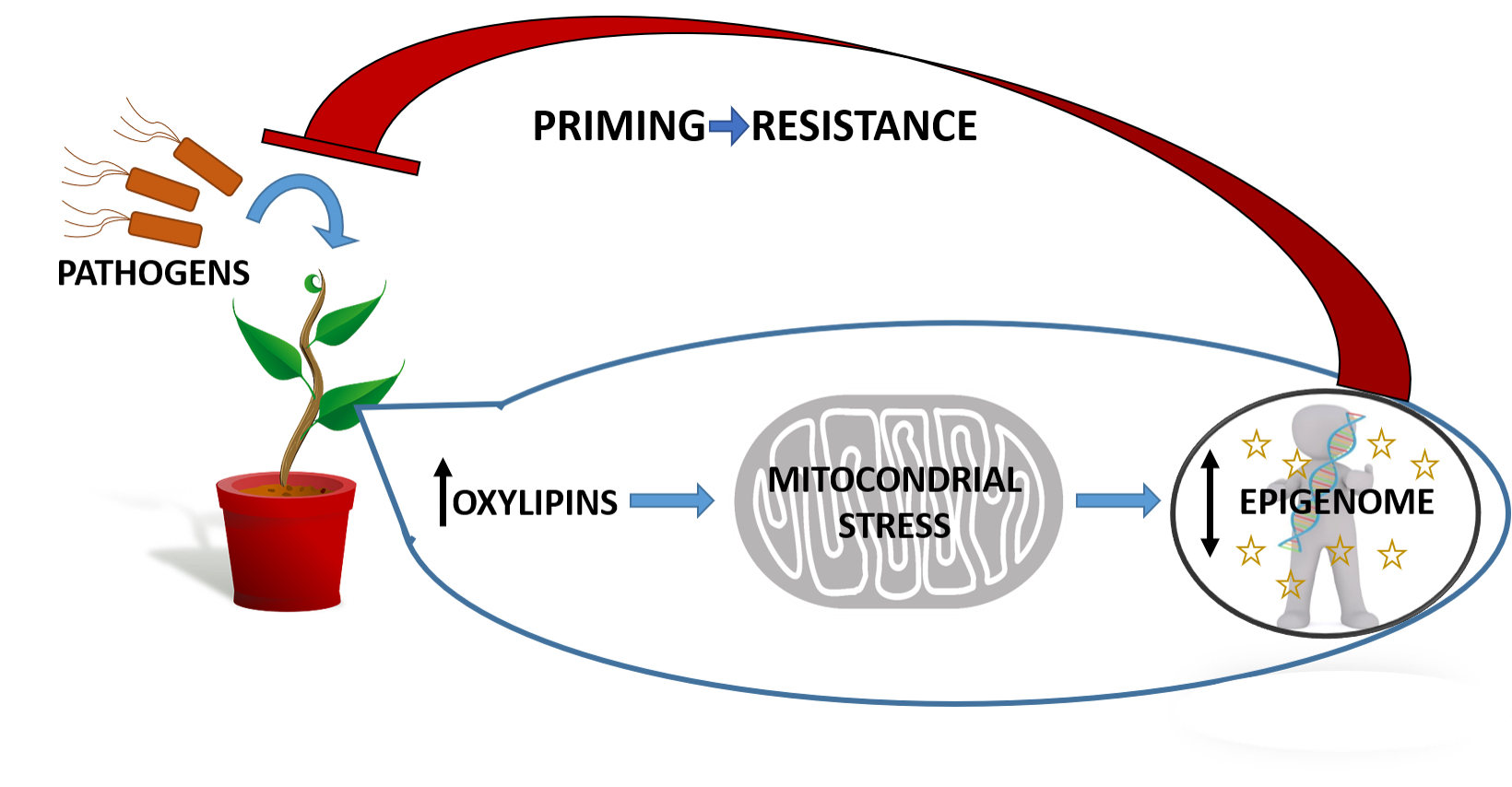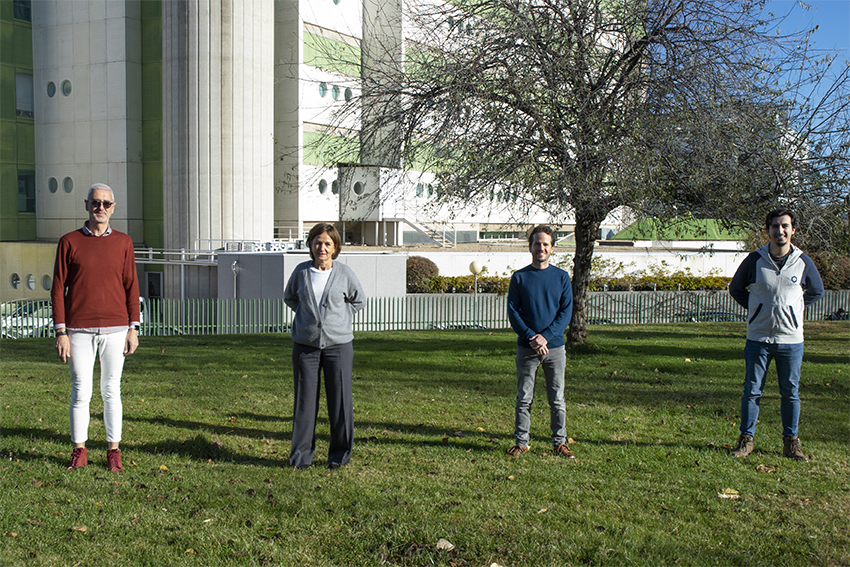Carmen Castresana
Group Leader
Research summary
Over the last years, we concentrate our interest in examining the activities in plant immunity of oxylipins, a family of lipid derivatives activating immune responses in plants. Our research has revealed that oxylipins produced by the biosynthetic pathways initiated by fatty acid alpha-dioxygenases (alpha-DOXs) and 9-lipoxygenases (9-LOXs) activate previously unknown immune responses protecting plants against the bacterial pathogen Pseudomonas syringae pv. tomato (Pst DC3000). In this response both enzymes collaborate to achieve full resistance against virulent strains participating in the three layers of defense -pre-invasion, apoplastic and systemic defense- triggered by plants against this type of pathogens. We have identified the oxylipins produced by these pathways and tested their activity. The investigation of these responses indicated that formation of lipid droplets, organelle coordination and communication, and translational regulation are critical processes to activate a robust immune response and that oxylipins are involved in these responses allowing plant survival.
Publications
López Sánchez A, Hernández Luelmo S, Izquierdo Y, López B, Cascón T, Castresana C. Mitochondrial Stress Induces Plant Resistance Through Chromatin Changes. Front Plant Sci. 2021 Sep 22;12:704964. eCollection 2021.
Izquierdo Y, Muñiz L, Vicente J, Kulasekaran S, Aguilera V, López Sánchez A, Martínez-Ayala A, López B, Cascón T, Castresana C. Oxylipins From Different Pathways Trigger Mitochondrial Stress Signaling Through Respiratory Complex III. Front. Plant Sci., 29 July 2021
Izquierdo Y, Fernández-Santos R, Cascón T & Castresana C. Lipid droplet isolation from Arabidopsis thaliana leaves. Bio-protocol 2020; 10: e3867–e3867.
Fernández-Santos R, Izquierdo Y, López A, Muñiz L, Martínez M, et al. Protein profiles of lipid droplets during the hypersensitive defense response of Arabidopsis against Pseudomonas infection. Plant Cell Physiol 2020; 61: 1144–1157
Wilkinson SW, Magerøy MH, López Sánchez A, Smith LM, Furci L, et al. Surviving in a hostile world: plant strategies to resist pests and diseases. Annu Rev Phytopathol 2019; 57: 505–529.
Vicente J, Mendiondo GM, Pauwels J, Pastor P, Izquierdo Y, et al. Distinct branches of the N-end rule pathway modulate the plant immune response. New Phytologist 2019; 221: 988-1000.
In our studies, we have increased our knowledge on the role of alpha-DOX and 9-LOX oxylipin pathways as well as of the products synthesized through them in the defense mechanisms activated by Arabidopsis following infection by hemibiotrophic bacteria.
We found alpha-dioxygenases in lipid droplets (LDs) which are formed after bacterial infection and that LDs participate in the production and transport of defense components affecting the interaction of plants with invading pathogens.
Studies with two members of the 9‑LOX oxylipin pathway, 9-HOT (9(S)-hydroxy-10,12,15-octadecatrienoic acid) and its ketone derivative 9-KOT, indicated that these oxylipins contribute to plant resistance by activating expression of defense-related genes and regulating hormone homeostasis (Ethylene, ABA, and Brassinoesteroids). Further examination of oxylipin action indicated that 9-HOT and 9-KOT act in the mitochondria causing mitochondrial aggregation and loss of mitochondrial membrane potential. The application of 9-HOT or 9-KOT does not alter mitochondrial respiration rates. Instead, they trigger a mitochondrial stress response by enhancing ROS production of respiratory complex III. We showed that induction of mitochondrial stress by exogenous application of AA in Arabidopsis activates plant resistance against different types of pathogens thus, supporting the contribution of mitochondrial stress to plant defense.
We isolated 9-HOT- and 9-KOT-insensitive mutants (noxy mutants, for non-responding to oxylipins). Among noxy mutants characterized, 8 mutations were located in NOXY genes encoding mitochondrial proteins or proteins functionally related with these organelles, thus supporting the role of mitochondria in 9-LOX signaling [57-59]. However, not all NOXY genes characterized encoded mitochondrial proteins. Thus, noxy22/ctr1 and noxy6/eto1 are located at the CTR1 (CONSTITUTIVE ETHYLENE RESPONSE1) and ETO1 (ETHYLENE OVERPRODUCER1) loci, encoding components of the ET signaling pathway with ER (Endoplasmic reticulum) and cytosolic localization, respectively. Moreover, NOXY7 encodes a homolog of the yeast translational regulator GENERAL CONTROL NON-DEREPRESSIBLE1 (GCN1) with cytosolic localization. In these studies we found that the translation of specific transcripts must play a role in plant immunity and that oxylipins may participate in the regulation of this response.

Figure Legend. Working model: Intracellular signaling process leading to plant defence and priming of immune responses. After a pathogen attack there is an intracellular increment in oxylipin production followed by disruption of mitochondrial function. The induced mitochondrial stress leads into epigenetic changes, which modify the inducibility of defence related genes, mediating a long-lasting resistance phenotype.








